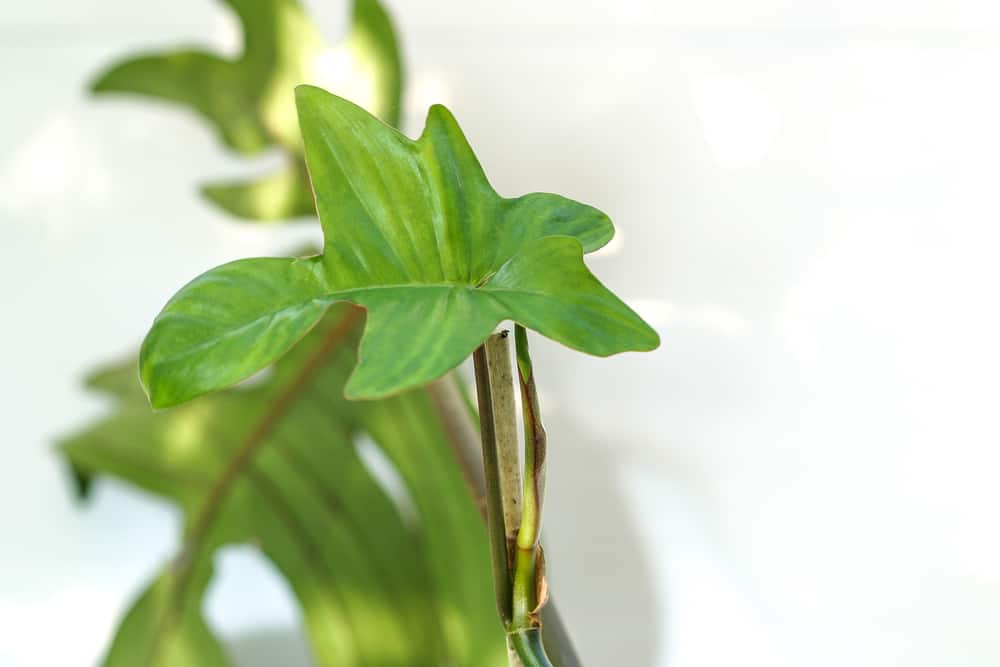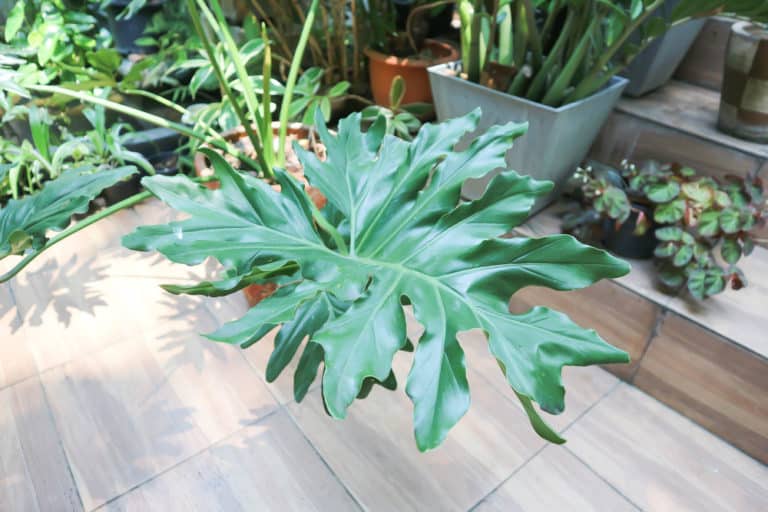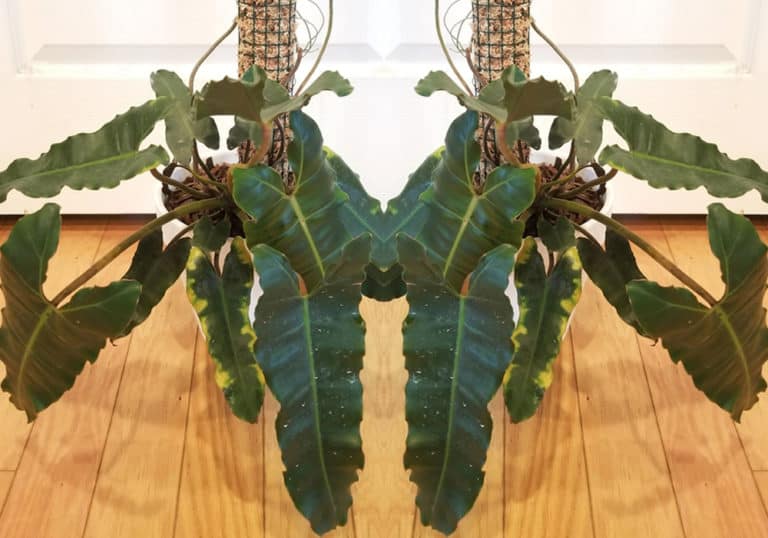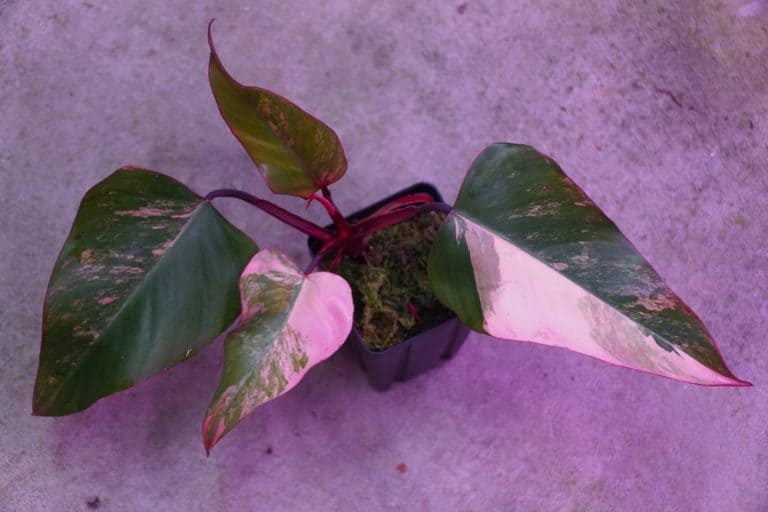Philodendron Squamiferum ‘Hairy Philo’ Care Guide (2024)

A lot of stunning ornamental foliage plants belong to the Philodendron genus. And among them is the Philodendron squamiferum, also known as Red Bristle Philodendron or Hairy Philodendron. It’s commonly grown as an indoor plant but also does well outdoors. Although a rare find, this species is an easy-to-grow one.
| Scientific Name | Philodendron squamiferum |
| Common Name | Red Bristle Philodendron, Hairy Philodendron |
| Light | Partial shade; Bright, indirect light |
| Watering | Medium |
| Temperature | 50°F to 77°F (10°C to 25°C) |
| Hardiness | Zones 9b to 11 when grown outdoors, Zones 4 to 11 if indoors |
| Humidity | 60% or more |
| Soil Type | Coarser, lighter, well-drained, rich in organic matter |
| Soil pH | Moderate to Slightly acidic (5.6 to 6.5) |
| Fertilizing | Fertilize once a month during the growing season |
| Repotting | Late spring or early summer (every 2 years) |
| Pruning | Best done in spring or fall |
| Propagation | Stem cuttings |
| Toxicity | Very toxic to both people and pets |
| Mature Size | Up to 18 inches in length |
| Bloom Time | Every May to July, once a year |
What’s Unique About Philodendron squamiferum?
The Philodendron squamiferum plant is native to French Guiana, Suriname, and northern Brazil. It belongs to the Araceae family and shares a lot of common features with other species of Philodendron. What sets it apart, though, is the presence of fuzzy hair covering its reddish stems. Those short hairs are termed “pubescence” in botany.
Both the leaves and stems are equally attractive. That’s why it’s a plant that is sought after by many plant collectors. Growing Philodendron squamiferum is relatively undemanding but it does require caution. Despite its beauty, it’s known to be very toxic. So, one should handle this plant with extra care.
Philodendron Squamiferum Care
The most important factors to consider when it comes to Philodendron squamiferum plant care are light, soil type and drainage, and humidity. Soil with good drainage prevents the occurrence of overwatering. Proper lighting allows the plant to produce enough of its own food. Correct humidity level makes it lush.
Below are more comprehensive details about P. squamiferum care.
Light
As a natural resident of the jungle, it’s given that Philodendron squamiferum light requirements would include indirect access to sunlight. You should keep the plant away from the full sun either indoors or outdoors. If outdoors, you can plant it under a tree canopy or inside a shade house. If indoors, place it in an area near a well-lit window.
Adding in LED grow lights also help achieve the P. squamiferum light needs if no sunlight is available. Lack of light will cause the leaves to turn pale and yellow while the whole plant becomes leggy. Keep the light optimal at most times for the plant to thrive.
Watering
Conduct Philodendron squamiferum watering once a week during the hot days in summer. Adjust it to every 12 days during the colder days in winter. Remember that this species has low watering needs. It’s highly sensitive to overwatering so you have to keep moisture level in control.
Another tip when you water squamiferum is to wait for the first few inches of the soil to dry. This would ensure that no excess water stays in the soil. Hence, you’ll prevent water stagnation from happening and in turn avoid root rot. Ensuring enough drainage holes in the pot also helps.
Temperature
It’s important that the growing environment meets the Philodendron squamiferum temperature range. Plants are like humans in the sense that they need a certain level of warmth in order to grow and develop. The best temperature for squamiferum lies between 50°F to 77°F (10°C to 25°C). Colder and warmer temperatures beyond this range can be harmful, especially with prolonged exposure.
If you’re living in areas under USDA hardiness zones 9b to 11, you can grow this plant outdoors. But if indoors, Zones 4 to 11 would be fine. Bear in mind that they have limited temperature tolerance. So, don’t expose them to extreme conditions like cold and hot drafts.
Humidity
When it comes to Philodendron squamiferum humidity requirements, remember that this plant originates from the jungle. Such a place is naturally moist and has a high humidity level. You should try to mimic this environment when cultivating your Red Bristle Philodendron at home.
The ideal humidity for squamiferum is 60% or more. To achieve this level, you may group your tropical plants together. This technique increases moisture as the water vapor transpired by the other plants can be absorbed by your P. squamiferum. The use of humidifiers is also another proven technique. And of course, manually misting around your plant also increases the humidity around it.
Soil
For better water retention and drainage, use sandy-textured soil mixed with sphagnum moss or coco coir. You may also use pine barks to create a coarse but light soil mix. Apart from having a well-draining property and water retention capacity, Philodendron squamiferum soil should also be fertile. The addition of organic matter is very helpful in creating a nutrient-rich medium.
The correct ph level for squamiferum is from slightly acidic to moderately acidic (5.6 to 6.5). A pH meter will help you measure this accurately. You can use a soil acidifier to adjust the pH if needed. Sterilize the soil for squamiferum before using it in potting.
Fertilizer
Dilute a Philodendron squamiferum fertilizer to half using water and apply it to your plant once a month or as needed. Don’t over-fertilize as this could harm the plant and cause immediate death. Apply fertilizer for squamiferum during the growing season only and stop when the winter season comes.
Most Philodendron species flourish when applied with an equal fertilizer ratio of nitrogen, phosphorus, and potassium (NPK). You can always check the label of the fertilizer to see this information. Through time, fertilizer salts will build up in the soil of potted Philodendrons. Leach them out by flushing water continuously on the soil. Do this repeatedly for a week.
Potting & Repotting
You should do Philodendron squamiferum repotting every two years or once the size has doubled. One clear indication would be the roots poking out of the drainage holes. There are many benefits of repotting squamiferum to a slightly larger container. It gives enough breathing room for the roots. It also provides enough medium for resources such as water and nutrients.
Choose a container that has a pot size that’s at most two inches larger. Prepare a new soil mix as a potting medium. Then, repot the whole plant to its new home. Be careful to keep the healthy roots intact. Water thoroughly and drain excess moisture. Repot only in late spring or early summer.
Pruning
Philodendron squamiferum pruning isn’t much required. You don’t have to regularly cut the stems and leaves because this plant is a slow grower. It’ll take time for it to grow to an uncontrollable size. There are instances, however, that you need to trim spent stems and leaves to keep the whole plant pretty. You should definitely cut aged and diseased leaves so the plant could redirect its energy into growing the healthy ones.
Before and after cutting squamiferum, remember to disinfect the tools that you’ll use. This is to maintain hygiene and prevent the potential spread of diseases. Make sure also that these tools are sharp and would make clean wounds.
Propagation
It’s a lot easier to conduct Philodendron squamiferum propagation using just a stem cutting. Make sure this cutting contains at least a node. This is where new roots will emerge. Either you plant the cuttings directly on the aroid soil or allow them to root in clean water first. Once roots have grown enough to support the plant, transfer it to a new pot to further grow.
Propagate squamiferum during the active season which is spring or summer. That way, rooting will take place easily. You may also place a plastic dome above the cuttings during the rooting process. This helps conserve moisture and prevent the cuttings from drying up.
Also, make sure to check out our in-depth Philodendron verrucosum plant care guide.
Common Problems of Philodendron squamiferum
It’s pretty common to encounter Philodendron squamiferum problems from time to time. Any plant can be vulnerable, especially when subjected to stress for too long. Some problems with squamiferum are noticeable on their leaves. This includes yellowing and/or browning. Another common and deadly disease is root rot which is from overwatering.
Pests
Philodendron squamiferum pests can be real trouble if left unattended. Tiny bugs such as aphids, scales, mealybugs, and even spider mites are constant but unwelcome visitors to many houseplants. These pests destroy the plant tissues by sucking up the sap. They leave lesions on the surfaces of leaves and stems which causes discoloration.
The majority of these squamiferum pests are pretty easy to handle. The first thing you have to do is take action at the onset of their existence. Spray them off with pressurized water to drive them away. You may also use soapy water or one that’s diluted with neem oil to kill them.
Diseases
Some major identified Philodendron squamiferum diseases are bacterial leaf spot, bacterial blight, and tip curl. These diseases are common to Philodendron species and they can bring severe damage to the plant. Bacterial leaf spot causes the leaves to turn brittle by creating tiny spots on the leaf edges. To control this disease, apply a copper fungicide.
Bacterial blight on squamiferum will leave dark green spots that become a wet rot after. These lesions have a foul smell. Once spotted, make sure to immediately remove the infected parts as this disease could lead easily spread to other parts. Tip curl causes the leaf tips to curl inwards. This is mostly due to fertilizer burns, hence, leaching is the immediate solution.
Growing Problems
Stunted growth is one of the indicators that your Philodendron squamiferum might have turned into a sick plant. It may be suffering from root rot which is why it has trouble absorbing water and nutrients. Symptoms include yellowing of the leaves as well as stems becoming mushy.
Other growing problems might be related to lack of light or overexposure to bright light. Lack of humidity can also stress the plant along with the unfavorable temperatures. That’s why it helps that you monitor these conditions from time to time. Be aware of your plant’s health by observing symptoms and signs of stress.
Toxicity of Philodendron squamiferum
P. squamiferum has serious toxicity issues. Well, this is common to any Philodendron species. It contains a high amount of calcium oxalates which when ingested or get in contact with, could lead to serious health troubles. It’s toxic to both humans and pets. And proper handling is required to avoid repercussions.
For Humans
The sap of Philodendron squamiferum plants will cause irritation once in contact with the skin of humans. This is because of the needle-like structures known as raphides that form from calcium oxalates. It will cause itching and irritation. We advise that you wear gloves when handling this plant.
Much trouble awaits if you happen to ingest any portion of the plant. It can lead to irritation of the mouth and other parts of the GI tract. Vomiting and diarrhea can also happen depending on how large the number of calcium oxalates was taken in. If you have children, make sure to keep this plant away from them.
For Pets
It also pays to take extra caution if you have pets around your home. The Hairy Philodendron is likewise toxic to our furry friends. If the calcium oxalates are damaging to humans, much more to small animals like dogs and cats.
If ingested, they can cause pain in the mouth, swelling, excessive drooling, and even difficulty in swallowing. It’s always a good idea to place the plant away from the reach of your pets. It will prevent them from messing with your Philodendron. If they ever ingested and showed toxicity symptoms, bring your pets to a veterinarian for immediate treatment.
Philodendron squamiferum Appearance
The unique thing about Philodendron squamiferum appearance is the presence of those red hairy bristles on its young stems. This term is known as pubescence. The purpose is to protect the young part of the plant and conserve moisture by reducing evaporation. It is primarily a foliage plant but it does produce flowers too.
Foliage
Dark green in color, five-lobed in shape with hairy, red petioles are the unique characteristics of the foliage of Philodendron squamiferum. The shape resembles that of the Monstera deliciosa but without the fenestrations. The younger leaf has a lighter shade of green compared to the older ones. The foliage makes a beautiful display indoors and outdoors.
When the plant is healthy, these leaves will display a vibrant and lush appearance. But if the plant is sick, the leaves will show symptoms like discoloration, curling, or limping depending on what type of problem persists. To keep the plant aesthetically pleasing, prune out the unhealthy-looking leaves.
Flowering
From May to July, Philodendron squamiferum flowering will occur. That is if the plant is already mature enough for reproduction. The blooming occurs once a year and during the warmer months. These flowers, however, are not as attractive as other flowering species and have no ornamental value. They usually go unnoticed.
The squamiferum flower is produced in a finger-like spadix that is enclosed by a pinkish spathe. Those tiny flowers produce seeds that you can later use for propagation. Blooming, however, is a rare occurrence for Philodendron kept indoors. Hence, you should lower your expectations when it comes to this.
Size and Growth
If treated as an indoor plant, the size of Philodendron squamiferum may reach up to 18 inches in length. This is because they have a limited potting medium unlike in the natural habitat where they live. If left in the wild, this plant can climb all the way up to tree canopies.
It has a slow growth rate so it will take a long time before it reaches mature size. But to encourage growth, you should conduct repotting and pruning when needed. Make sure it receives the best growing conditions. With less stress, Philodendron squamiferum will grow healthily and happily.
Philodendron squamiferum Fragrance
The interesting part with regard to Philodendron squamiferum fragrance lies in its flowers. Those blooms produce a very noticeable scent during the nighttime. Reports of some gardeners who witnessed its flowering said that it smells like a lily. However, the smell doesn’t last that long. You’d be lucky to witness this if your plant ever flowers.
The foliage, on the other hand, remains unscented. So, there is nothing much to expect in there. But that’s totally fine because the beauty of the foliage doesn’t disappoint. You can still enjoy the plant with or without the presence of those fragrant flowers.
Suggested Uses for Philodendron squamiferum
Philodendron squamiferum has a high ornamental value. It is rare in captivity but is easy to maintain and care for once cultivated. It does well both indoors and outdoors. You can plant it in pots and place it inside your home as a foliage display. The leaves will surely help produce fresh air around your house.
Some collectors also include this plant in their conservatory gardens. You can also let it climb on a tree outdoors, much like how it does in its natural habitat. Due to its epiphytic nature, you may also plant this Philodendron in hanging baskets to trail downwards.
FAQ
What is Philodendron squamiferum?
Philodendron squamiferum is another species of the Philodendron genus that comes from the Araceae family. It is commonly known as Red Bristle Philodendron or Hairy Philodendron.
How to identify Philodendron squamiferum?
The young stems and petioles of P. squamiferum are characterized by having red bristles or hairs. This is termed “pubescence” in botany. It also has dark green, five-lobed leaves.
How to care for Philodendron squamiferum?
Plant it in an area with partial shade, high humidity, and warm temperature. Water moderately and make sure excess water drains out to avoid building up stagnant water.
How to grow Philodendron squamiferum indoors?
Pot in a container that has good drainage. Place your potted P. squamiferum beside a window with bright but indirect light. Keep humidity high. Water when the top surface of the soil dries out.
How to grow Philodendron squamiferum outdoors?
Keep in a place under partial shade, usually under tree canopies or greenhouses. Avoid overwatering the plant. Trim down overgrowth portions to prevent the plant from outgrowing the tree.
How fast does Philodendron squamiferum grow?
Hairy Philodendron is a slow-growing plant species. It will take a little more time to mature and outgrow its pot. You’d have to wait two years before you could repot.
How tall does Philodendron squamiferum grow?
An indoor Hairy Philodendron will grow as much as 18 inches tall. But if left in the wild, it could grow as much as one meter high and above.
How to make Philodendron squamiferum grow faster?
Give the best-growing conditions as much as possible. Plants will grow better when there’s not much stress around them. Also, add fertilizer once a month during the growing period.
How to stake Philodendron squamiferum?
Use a sturdy stake such as a moss pole for support. Start staking when the plant is still young and easier to maneuver. Tie the main stem to the stake without being too tight or too loose.
How to pot Philodendron squamiferum?
Prepare a container with good drainage. It shouldn’t be too large or too small. Fill it in with an aroid soil mix. Carefully plant your Philodendron making sure that it’s firmly set in the pot.
How to revive Philodendron squamiferum?
Adjust the growing environment so it becomes ideal for the plant. It could be light, temperature, humidity, soil condition, etc. This way, you eliminate the possible stressors.
Why is my Philodendron squamiferum dying?
There could be many reasons so it’s a must to investigate. Check the soil and roots for signs of overwatering and fertilizer burns. Check the leaves for disease symptoms.
Why is my Philodendron squamiferum drooping?
Your plant may be experiencing watering problems. It may be too moist or too dry, so please check the soil condition. Another reason might be due to a certain disease.
How cold can Philodendron squamiferum tolerate?
Generally, Philodendron squamiferum loves warm temperatures but it can tolerate cold temperatures as low as 50oF (10oC). Lower than that, this plant may suffer irreversible damage.
How to get rid of pests on Philodendron squamiferum?
Spray them off with pressurized water. If they remain persistent, you can use diluted solutions containing neem oil and insecticidal soap. Prune heavily infested parts.
Is Philodendron squamiferum toxic to cats?
Philodendron squamiferum is toxic to cats. It contains a high amount of calcium oxalates that can be toxic when ingested. This compound forms needle-like structures that can irritate the tissue.
Is Philodendron squamiferum toxic to dogs?
Yes. Dogs aren’t spared from the toxicity of Philodendron squamiferum. The calcium oxalates could irritate their GI tract leading to problems like vomiting, drooling, and pain.
Is Philodendron squamiferum toxic to children?
Yes, this species is toxic to children. Ingestion of any plant parts could lead to serious health problems. Keep it away from your kids as a safety precaution.
Is Philodendron squamiferum toxic to humans?
Yes. This toxicity is due to the presence of high amounts of calcium oxalates. Skin contact with its sap may cause irritation while ingestion can lead to gastrointestinal problems.
Does Philodendron squamiferum have a scent?
The leaves of Philodendron squamiferum are unscented but the flowers produce a fragrant smell resembling that of a lily. The scent is more noticeable at night and doesn’t last long.






